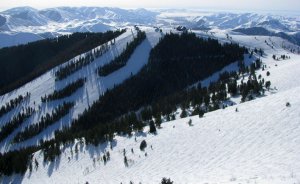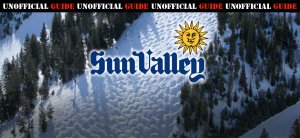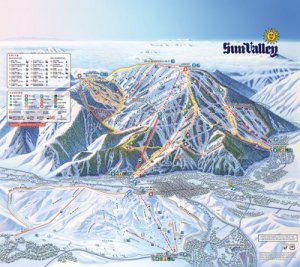
For a high Resolution (PDF) map, click here
For an interactive Bald snd Dollar Mountain Maps, click here
Bill Miles' Unofficial Guide to Skiing Sun Valley
Introduction and History
Sun Valley is located in South Central Idaho about 120 miles east of Boise. Nonstop flights by regional jet or tuboprop are seasonally avaiable from Seattle, Salt Lake City, Los Angeles, San Francisco, Chicago, Portland and Denver. Access by car is North by US93/ID75 from I-84 at Twin Falls (about 75 miles) or Southeast then East then North from Boise by I-84, US20 and ID75 (about 150 miles). Bus shuttles from Boise are available. For those making a road trip to multiple resorts, both the SLC areas and Jackson/Targhee are about a 4-1/2-5 hour drive.
Sun Valley was founded in the 1930’s, then consisting of the Sun Valley Resort (see below) and skiing on nearby Ruud and Proctor Mountains featuring the world’s first chairlifts. Within a few years, skiing expanded to the top of nearby Bald Mountain via three single chairlifts in series up the River Run side of the Mountain. The resort was initially owned by the Union Pacific Railroad (there used to be rail service, but no longer) under the leadership of Averill Harriman. Postwar ownership passed to Bill Janss, then to Earl Holding in 1976. Mr. Holding made substantial investments, including high speed lifts, extensive snowmaking and upscale day lodges. Mr. Holding also owns Sinclair Oil, Snowbasin in Utah, and hotels in the Western U.S.
Mr. Holding passed away in 2013. There has been some speculation about future developments, but it appears the family will continue to own and manage based on their recent announcement of a major remodel and addition to the Sun valley Lodge, made by Mr. Holdings wife and son.
What is Sun Valley?
There is a lot of confusion on this among new or prospective visitors. The following describes areas and locations associated with Sun Valley:
- Sun Valley Resort--The area including Sun Valley Company hotels (Sun Valley Lodge and Sun Valley Inn), condos, restaurants, shops, etc., located up the hill East of Ketchum. It is not located at the ski mountains themselves.
- City of Sun Valley--A separate government municipality including the Sun Valley Resort and some immediately surrounding area.
- General Area—The whole area is often referred to as Sun Valley, more officially known as the Wood River Valley.
- Ketchum--The larger town (a separate government municipality) located in the bottom of the Valley between the resort and Bald Mountain.
- Bald Mountain (Baldy)—The large main ski mountain located mostly west of Ketchum.
- Dollar Mountain—A smaller ski mountain, mainly oriented toward beginner skiers, park and pipe skiers and lessons, located south of the resort.
- Hailey--A larger town about 11 miles south of Ketchum. The Sun Valley Airport (officially Friedman Memorial Airport) is located at the South End of Hailey.
The trail map aove shows both ski mountains, the resort, and Ketchum. Below is a view looking down valley from the top of Baldy, toward Seattle Ridge, Hailey, the airport (and my house.)
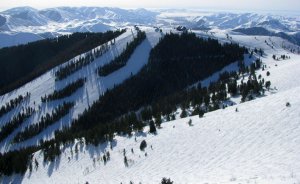
Looking downvalley toward Seattle Ridge, Hailey, and my house
Multi-Mountain Passes
Up through 2018/2019, Sun Valley was part of MCP. For 2019/2020, Sun Valley will be affiliated with Epic, but not a Vail Resort, where Epic passholder receive 7 days at Sun Valley and Epic Local passholders receive 2 days.
Sun Valley passholders will receive 50% discount at Epic resorts along with unlimited days at sister resort Snowbasin. Not a good change IMHO.
Skiing Bald Mountain
Highlights and Lowlights—The following are things that Bald Mountain is noted for, both good and bad:
Snowfall—Not a lot. In the last eighteen years, the most season snowfall was 350” and the least was 129” (in 2014/2015 when the season still ran from Thanksgiving to April 6th). The season normally runs from Thanksgiving to the third week in April, with the latest opening being Dec. 10 and the earliest closing being April 6 (except for 2019-2020 due to Covid). The biggest storms tend to be late December and early January. The low snowfall is offset by extensive snowmaking on the Main Mountain, Seattle Ridge and Dollar Mountain.
Snow Quality and Grooming—The biggest storms tend to come from the Southwest through Northern California, resulting in snow that is usually not as light as other Rocky Mountain areas. This is offset by extensive high quality grooming on all green runs, most blue runs, and a few black runs. Between snowfall and snow quality, Sun Valley is not really a powderhound’s paradise.
Uniform Pitch and Steepness—Baldy does not have a lot of real steep runs comparable to Jackson Hole or Snowbird, but its pitch is uniform (not very many steeps followed by flat runouts), and its average steepness compares with anything. Between the grooming, pitch and lack of crowds, Baldy is excellent for really ripping, as discussed later. Here is a comparison based on steepness of some long Western US lifts:
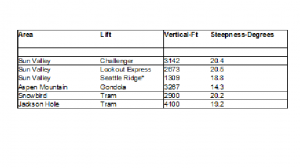
*This is included not because of length or steepness, but for illustration purposes because this lift serves Green runs, two of which are about the same steepness as the lift.
Weather—They don’t call it Sun Valley for nothing.
Elevation--With a base elevation of 5750' and a top elevation of 9150', Baldy is lower than most Rocky Mountain resorts.
Crowds—Minimal. A 5 minute wait during busy season is long.
Expense—High, but not as bad as say, Aspen or Vail, except for season passes, which are about the highest in the country.
Run Names--An interesting item is that if you are an area local and a Winter Olympic medalist, they will name a run after you. Examples include Gretchen's Gold (Gretchen Fraser), Christen's Silver (Christen Cooper) and Picabo's Street (guess who). Runs named after other local celebrities inlcude Janss Pass and Arnold's Run. The latter is not where he broke his leg; it was the green Lower Warm Springs. On March 2, 2014, Farout Bowl was renamed Kaitlyn's Bowl in honor of local Kaitlyn Farrington (she was in my stepson's high school class), who won a Gold in the 2014 Winter Olympics Women's Snowboard Half-Pipe.
General Layout—Bald Mountain has two base areas, River Run at the south end of Ketchum, and Warm Springs to the north of Ketchum. Both include rather upscale base lodges with restaurants, ticket offices, and equipment and rental shops. If you are driving, the parking situation is better at River Run. Parking is free and lots are about a quarter mile from the base area, however there is a parking lot shuttle. The parking situation has improved at Warm Springs (it is no longer pay), and if you get there early you can park in the upper lot where it is only a few steps from Lower Greyhawk run to ski down to the lifts and lodge. It is about a 15 minute longer drive if you are coming from the South.
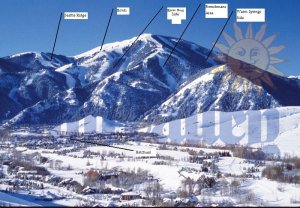
Ketchum and Bald Mountain from the Sun Valley Resort
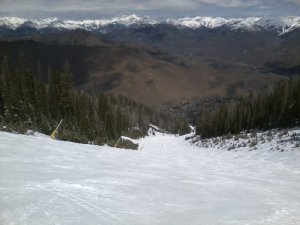
View looking down at the Warm Springs base area. There are condos across the street from the base, and the only ski-in/ski-out condos at the International Village adjacent to the base.
Areas of the Mountain
River Run side of Main Mountain—This is accessed from the River Run base area in one of two ways:
- The short River Run HSQ (650’ vertical, serving the flattest and easiest Green run on the mountain) followed by the longer (2670’ vertical) Lookout Express chair to the top, or
- The Gondola, which goes to the Roundhouse Restaurant (built in the 1930’s and known for an upscale menu and dining experience) followed by the Christmas HSQ to the top.
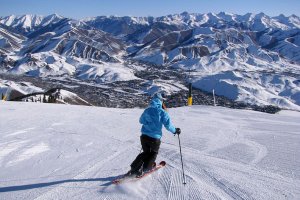
Heading Down Upper College—River Run to Right, Warm Springs to Left
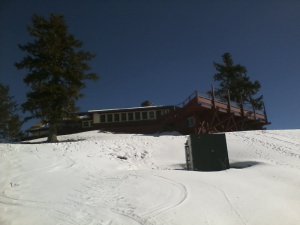
Roundhouse Restaurant 2/3 way up the River Run Side. Gourmet lunch and dinner (access via Gondola) in a historic setting.
Warm Springs side of Main Mountain—This is accessed by the Challenger HSQ from bottom to top (3140’ vertical, the most for a chair in North America). There is also the Greyhawk HSQ, which serves the lower half of the Warm Springs side, including the runs used for races just the north of the Greyhawk chair.
Frenchmans area of Main Mountain—The River Run and Warm Springs side of the main mountain are separated on the top 800’ vertical by a prominent ridge along which is a green run known as Upper College. From the bottom of Upper College one can proceed right to the River Run side, left to the Warm Springs side or more or less straight to the Frenchmans area, which is served by its own medium length (1500’ vertical HSQ). There is no ski out from the bottom.
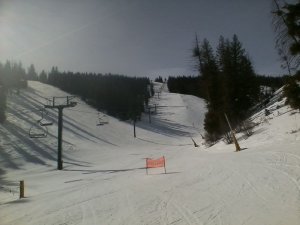
Looking up from the bottom of Frenchmans at Lower Can-Can (left), and Undergraduate (right), which are two of the steeper blues on the mountain.
Bowls—These lie below a ridge to the South of the top of the Main Mountain. Several adjacent runs can be accessed directly, while the remainder can be accessed by the short Lookout triple (known informally as “The Chair to Nowhere”) which runs to the highest point on the ridge and the mountain. The Bowls are served by the medium length (1600’ vertical) Mayday triple.
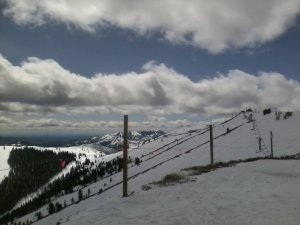
The top portion of the bowls from top of the main mountain; Lookout chair to the right, and Mayday chair in the background.
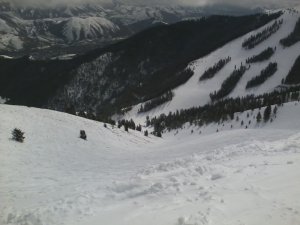
Looking down Little Easter Bowl
Seattle Ridge—This is a North facing area of semi-green (more later) runs located to the south of the bowls and served by the Seattle Lodge HSQ (1300’ vertical). It can be accessed from the bowls, from the top of the Bowls along the ridge, or by the Guntower Lane catwalk from the Roundhouse. At the top is another upscale day lodge and restaurant. This is the busiest part of the mountain, so it is best to hit it early.

Looking at Seattle Ridge from Main Mountain—those are Green Runs
Cold Springs/Lower Bowls—This area is below Seattle Ridge and the Bowls. It is served by the Cold Springs double (1000’ vertical) to the Roundhouse and is one of two ways to return to the Main Mountain. The other is to take the Mayday lift back to the top of the bowls and ski back along the ridge. There is no ski out from the bottom. For 2020/2021, the Cold Springs lift will be replaced by a considerably longer HSQ extending 3400' feet further down the canyon. This will also publicly open Turkey Bowl on the east side of Seattle Ridge.
Other Lifts—There were two older slow lifts which connected the River Run and Warm Springs side to the central upper ridge just above the bottom of Upper College. The Sunnyside triple ran from the top of the Lower River Run lift and the Flying Squirrel double ran from a short distance up the Warm Springs side. They were not used much and were often closed except in peak periods or in case of stoppage of the main lifts. There is also a short Magic Carpet at the River Run base. The building housing the upper lift terminal of Flying Squirrel burned down in 2014. In the summer of 2014, the Sunnyside lift and the remains of the Flying Squirrel lift were removed.
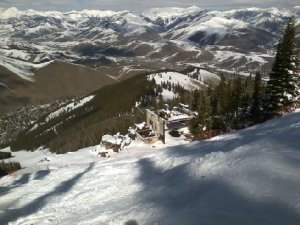
Remains of flying Squirrel upper lift terminal
Exposures
Bald Mountain exposures run from North through East to South, with the predominant exposure, as judged by the upper ridge separating River Run Side from Warm Springs side being East-Northeast. Southerly runs include runs from River Run side towards the bowls, such as Ridge South Slope, and runs from Lower College down towards Mid River Run, known as College South Slopes although not labeled on the trail map. Northerly runs include Seattle Ridge and most Warm Springs runs. The ridges separating the various Bowls have both Southerly and Northerly sides. The consequences of these exposures are as follows:
- The morning sun hits runs on upper River Run such as Ridge, Christmas Ridge and Upper College, so they are popular at this time. They are first to soften in late season, but tend to get slushy during the afternoon in late season.
- Warm Springs runs and lifts are in the shade most of the day during early season (Warm Springs run becomes sunny all the way down about 1:30 PM in mid-February) and is known as the refrigerator. Conversely, this area, especially the Greyhawk area, usually has the best snow during late season afternoons.
- The Southerly slopes are often sketchy or bare during early or late season or during a low snow year. Northerly aspects of the Bowls can be perfectly skiable while Southerly aspects are bare.
- Seattle Ridge runs, due to both their exposure and meticulous grooming, often have the best snow on the mountain, at least for a groomer.
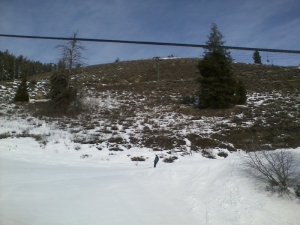
College South Slopes in March in a low snow year
Sun Valley for Types of Skiing
Bald Mountain for Powder Skiers—Not really your place, as discussed above under Snowfall and Snow Quality, but you might get lucky. On a powder day, the Bowls stand out. Cold Springs/Lower Bowls and College South slopes (not on map) are good on a good snow coverage year. For runs not quite as steep and more protected, Frenchmans area is good.
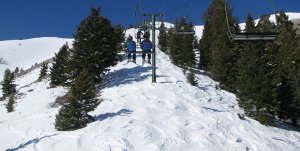
Heading Up Mayday Chair to Top of Bowls
Bald Mountain for Mogul Skiers: In spite of the extensive grooming most black runs are ungroomed, pretty steep and develop good moguls. Exhibition (no longer under a chair) is a historical classic. Other notable Mogul runs include Holiday, Upper and Mid Picabo’s Street, Upper Hemingway, Upper Cozy, Upper River Run and portions of the Bowls, although the upper portions are wide open enough that they don’t develop moguls.
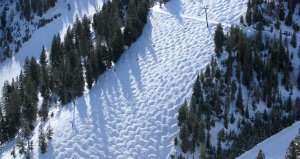
Moguls on Mid Holiday—Canyon (Groomer) In Background
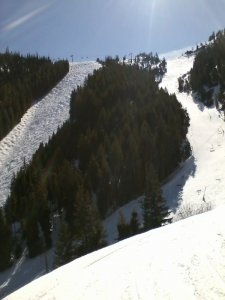
Exhibition (Black mogul run which used to have a chair running up it), left, and Canyon (blue groomer), right.
Bald Mountain for Groomer and/or fast Skiers. This is your place. All greens and most blues are groomed daily. Long uniformly pitched runs on the Main Mountain are widely available, including several top to bottom on the Warm Springs side, and top to most of the way to the bottom on the River Run Side (many skiers don’t go all the way to the bottom because the bottom portion is flat.) Seattle Ridge has shorter groomers and although they are marked green, they are steep enough that they would be blue on most mountains and are a fun cruise early before the crowd hits. The Blue runs in Frenchmans area are quite steep for a Blue, especially the lower portions, with one or two usually groomed. Black runs that are frequently groomed are Limelight, Upper Greyhawk and International. My favorite run is Limelight to the last catwalk, cutover to Upper Greyhawk, then down to the bottom for 3142’ vertical nonstop.
If you use common sense when the runs are uncrowded, there is no problem with going fast. Some runs that are good for this early are Warm Springs, Ridge, and the Seattle Ridge runs (marked slow skiing but OK first thing in the morning). Best runs for going fast at other times are mid and lower Greyhawk, Hemingway and Cozy. Between the runs, long fast chairs, and lack of crowds I have never seen a better mountain for piling up the vertical.
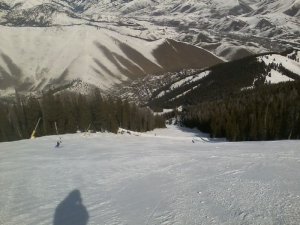
Looking down Limelight, a black groomer
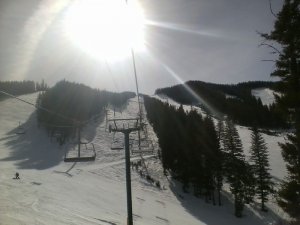
Looking up the Challenger chair on Warm Springs. Upper Greyhawk, probably the steepest groomer, is to the immediate upper right of the chair.
Bald Mountain Steeper Runs-- A summary of some of the steeper runs in various categories is as follows:
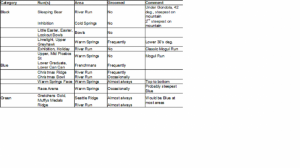
Ridge designation was changed to Blue in 2017/2018. Inhibition changed to Double Black, but not Sleeping Bear for some reason.
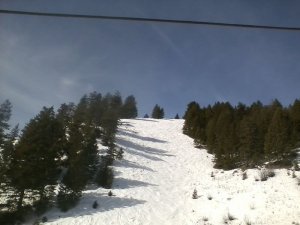
Inhibition, 2nd steepest run on mountain.
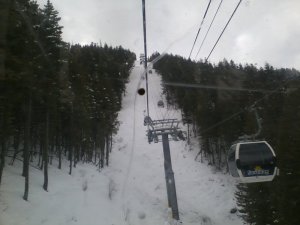
Sleeping Bear--steepest run on mountain
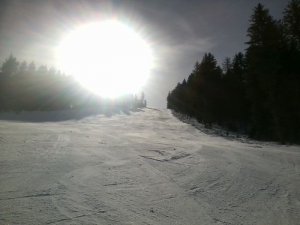
Looking up Race Arena, steepest Blue, but short.
Bald Mountain for Beginners—You are probably better off on Dollar until you gain some skills and confidence. Lower River Run is flat, but is short, boring and sometimes gets crowded with skiers headed to the bottom. Of the four green runs on Seattle Ridge, three would be Blue at most other Mountains, along with Ridge on the River Run side. Lower Warm Springs and Upper and Lower College are less steep, but not flat and tend to get busy and/or chopped up. In addition, Dollar is considerably less expensive for a ticket, specializes in lessons and still has 650’ of vertical and two high speed lifts.
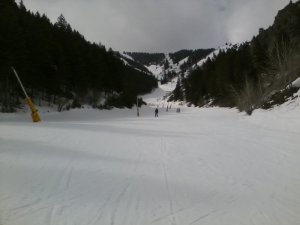
Lower River Run-Easiest Green on the mountain
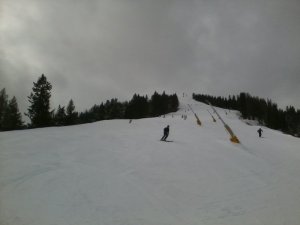
Upper College--Easiest Green off the top (continuing down Lower College about the same)
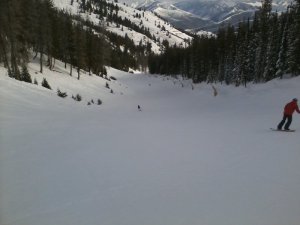
Broadway--Easiest Green (and only true Green) on Seattle Ridge
Park and Pipe—The park and pipe are located on Dollar mountain. Since I can’t provide much information, here is what the Sun Valley Company has to say: http://www.sunvalley.com/mountain/park/
Nordic-- Sun Valley Company has a Nordic Center and groomed trails at the golf course adjacent to the resort. There are also extensive independent Nordic trails at the Galena Lodge area about 15 miles north of Ketchum.
Sidecountry and Backcountry--Sidecountry skiing is allowed. Primary routes are off the backside of the Bowls, and in burned forest area to the north of the Warm Springs side. These areas may be sketchy in a low snow year. Extensive backcountry is available in the Sawtooths north of Ketchum. This link mentions some local guides available for both sidecountry and backcountry: http://www.fs.usda.gov/detail/sawtooth/news-events?cid=STELPRDB5345677.Heliskiing is available from: http://www.sunvalleyheliski.comwww.sunvalleyheliski.com
Attachments
Last edited:

